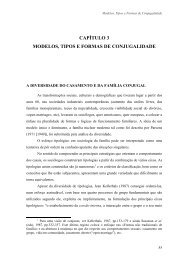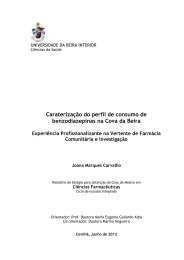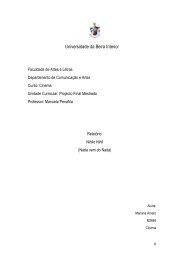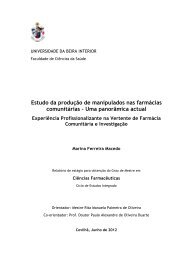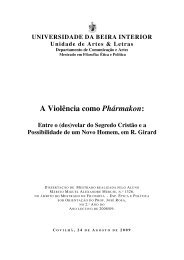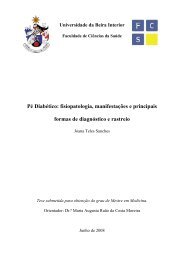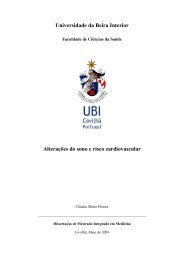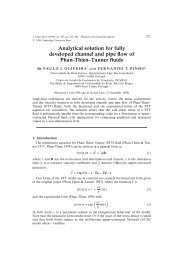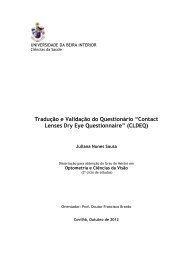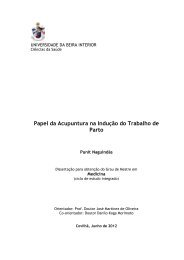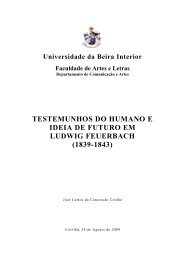Tese_Tânia Vieira.pdf - Ubi Thesis
Tese_Tânia Vieira.pdf - Ubi Thesis
Tese_Tânia Vieira.pdf - Ubi Thesis
You also want an ePaper? Increase the reach of your titles
YUMPU automatically turns print PDFs into web optimized ePapers that Google loves.
Chapter I - Introduction<br />
chloride (Silver 2003), which decreases silver bioavailability and increases bacterial silver<br />
resistance (Marambio-Jones et al. 2010). Resistant bacteria also have modified plasmids that<br />
confer this resistance (Silver 2003), in this case, resistant cells appeared to develop reduced<br />
permeability to silver combined with an upgraded active efflux mechanism that pumps silver out<br />
of the cell and protecting the cytoplasm against toxic concentrations of silver (Parikh et al.<br />
2008). It is therefore clear that non-controlled use of silver in sublethal levels may result in<br />
development of resistance by the bacteria, like to other antibiotics (Atiyeh et al. 2007).<br />
1.3.4. Toxicity of silver nanoparticles<br />
Silver toxicity for different organisms is known for a long period (Cumberland et al. 2009)<br />
and has been described by different researchers (Huh et al. 2011). Silver toxicity can cause an<br />
irreversible skin pigmentation (arygria - a permanent disorder caused by silver deposition in the<br />
skin’s micro vessels in patients who are exposed to high quantities of silver, 50,000-300,000 ppm)<br />
and pigmentation in the eyes (agyroses) (Rai et al. 2009; Huh et al. 2011). In addition, other<br />
toxic effects include organ damage, (e.g., the deposition of silver in liver and kidney), irritation<br />
(e.g., eyes, skin, respiratory, and intestinal tract), and changes in the blood cell counts (Arora et<br />
al. 2008; Huh et al. 2011; Kurek et al. 2011). Beyond the toxicity for the several organisms,<br />
heavy metal accumulation in the environment has been mentioned by the United States Agency<br />
for Toxic Substances and Disease Registry (ATSDR) as well as by the European Commission as a<br />
concern (Monteiro et al. 2009). Nevertheless, silver has not been cited amongst the most<br />
prevalent heavy metals, and it is not in the priority list of hazardous substances for public health<br />
(Monteiro et al. 2009).<br />
Conversely, the citotoxicity of AgNPs is not fully characterized (Sheikh et al. 2010). AgNPs<br />
have an advantage over ionic silver because of their efficacy at low concentrations (Pal et al.<br />
2007; Gurunathan et al. 2009) show reduced toxicity and higher antibacterial potential (Kurek et<br />
al. 2011; Prucek et al. 2011). The toxicity of AgNPs is concentration-dependent (Monteiro et al.<br />
2009), and therefore, it is prudent to incorporate a minimum amount of silver in the organism,<br />
for example on implant surfaces in order to reduce bacterial adhesion as well as minimizing<br />
tissue cytotoxicity (Chen et al. 2006). Moreover, several studies reported that AgNPs significantly<br />
decreased the function of mitochondria and induced cell necrosis or apoptosis in several cell<br />
types (Yen et al. 2009; Huh et al. 2011), via the production of ROS, which leads to cell death<br />
(Atiyeh et al. 2007). It was also observed liver function abnormalities, following acute silver<br />
toxicity (50 µg/mL) due to nanocrystalline silver (Atiyeh et al. 2007).<br />
A consensus about the detailed molecular mechanism of action of AgNPs that is responsible<br />
for its toxicity is still missing (Mohammed Fayaz et al. 2009; Arvizo et al. 2012). It is possible to<br />
state that a lack of physical barriers for nanoparticle diffusion into cells, determines their<br />
generalized (bio)availability, with the risk of a massive uptake by eukaryotic cells, which<br />
eventually leads to their death (Mohammed Fayaz et al. 2009). In fact, the issue of possible<br />
adverse effects and toxicity of nanoparticles for the human body is progressively recognized as a<br />
14




